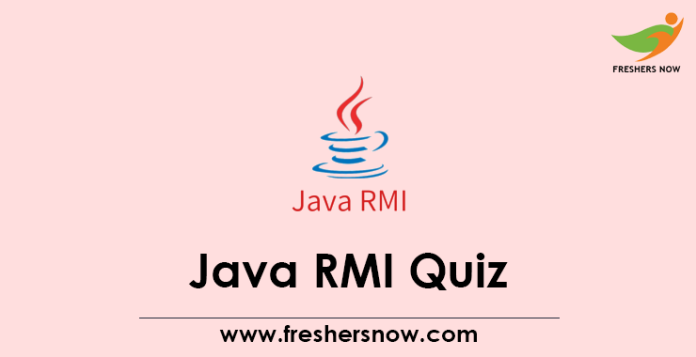
Java RMI Quiz – Multiple Choice Questions and Answers: Want to check how much you are aware of Java Remote Method Invocation (RMI)? Then, give a look at this article. For your sake, we have accommodates this page Java RMI Quiz. Take up the Remote Method Invocation (RMI) Online Quiz Test and get to know in what areas you need improvement. Immediately after submitting your response on Java RMI Mock Test the Java RMI Multiple Choice Questions and Answers will be displayed on the screen. If you would like to take up more quizzes like Java RMI Online Quiz, do check out the technical quiz page on our portal.
Java RMI Quiz – Details
| Quiz Name | Java RMI |
| Exam Type | MCQ (Multiple Choice Questions) |
| Category | Technical Quiz |
| Mode of Quiz | Online |
Java RMI Online Quiz – Practice Here
What does RMI stand for?
a) Remote Method Invoker
b) Remote Method Invocation
c) Remote Method Interface
d) Remote Method Implementation
Answer: b) Remote Method Invocation
Explanation: RMI stands for Remote Method Invocation, which is a Java API used for creating distributed applications in Java.
Which protocol does RMI use for communication between client and server?
a) HTTP
b) FTP
c) TCP/IP
d) UDP
Answer: c) TCP/IP
Explanation: RMI uses TCP/IP protocol for communication between client and server.
Which class is used to create remote objects in RMI?
a) RemoteClass
b) RemoteObject
c) RemoteInterface
d) RemoteStub
Answer: b) RemoteObject
Explanation: The RemoteObject class is used to create remote objects in RMI.
Which interface is used to define the remote methods in RMI?
a) RemoteClass
b) RemoteObject
c) RemoteInterface
d) RemoteStub
Answer: c) RemoteInterface
Explanation: The RemoteInterface is used to define the remote methods in RMI.
Which method is used to register a remote object with the RMI registry?
a) rebind()
b) bind()
c) lookup()
d) unbind()
Answer: b) bind()
Explanation: The bind() method is used to register a remote object with the RMI registry.
Which method is used to invoke a remote method in RMI?
a) invoke()
b) call()
c) execute()
d) dispatch()
Answer: a) invoke()
Explanation: The invoke() method is used to invoke a remote method in RMI.
Which exception is thrown when a remote method invocation fails in RMI?
a) RemoteException
b) ClassNotFoundException
c) IllegalAccessException
d) InvocationTargetException
Answer: a) RemoteException
Explanation: The RemoteException is thrown when a remote method invocation fails in RMI.
Which method is used to create a stub object in RMI?
a) createStub()
b) createObject()
c) createRegistry()
d) createServer()
Answer: a) createStub()
Explanation: The createStub() method is used to create a stub object in RMI.
Which method is used to export a remote object in RMI?
a) export()
b) register()
c) bind()
d) lookup()
Answer: a) export()
Explanation: The export() method is used to export a remote object in RMI.
Which class is used to create the RMI registry?
a) RegistryClass
b) RegistryObject
c) LocateRegistry
d) RemoteRegistry
Answer: c) LocateRegistry
Explanation: The LocateRegistry class is used to create the RMI registry.
What is the default port number used by RMI registry?
a) 1098
b) 1099
c) 1100
d) 1101
Answer: b) 1099
Explanation: The default port number used by RMI registry is 1099.
Which interface is used to get a reference to a remote object in RMI?
a) RemoteObjectRef
b) RemoteReference
c) RemoteRef
d) RemoteStub
Answer: c) RemoteRef
Explanation: The RemoteRef interface is used to get a reference to a remote object in RMI.
Which interface is used to define the behavior of the client-side of a remote object in RMI?
a) RemoteClient
b) RemoteObject
c) RemoteRef
d) RemoteStub
Answer: d) RemoteStub
Explanation: The RemoteStub interface is used to define the behavior of the client-side of a remote object in RMI.
Which class is used to create a server object in RMI?
a) UnicastServer
b) RemoteServer
c) ServerObject
d) RmiServer
Answer: b) RemoteServer
Explanation: The RemoteServer class is used to create a server object in RMI.
Which method is used to create a proxy object in RMI?
a) createProxy()
b) createObject()
c) createRegistry()
d) createServer()
Answer: a) createProxy()
Explanation: The createProxy() method is used to create a proxy object in RMI.
Which method is used to set the security manager in RMI?
a) setSecurityManager()
b) setManager()
c) setRegistry()
d) setProxy()
Answer: a) setSecurityManager()
Explanation: The setSecurityManager() method is used to set the security manager in RMI.
Which interface is used to define the behavior of the server-side of a remote object in RMI?
a) RemoteServer
b) RemoteObject
c) RemoteRef
d) RemoteStub
Answer: b) RemoteObject
Explanation: The RemoteObject interface is used to define the behavior of the server-side of a remote object in RMI.
Which method is used to obtain the stub for a remote object in RMI?
a) getStub()
b) getReference()
c) getProxy()
d) getObject()
Answer: a) getStub()
Explanation: The getStub() method is used to obtain the stub for a remote object in RMI.
Which exception is thrown when the server is not reachable in RMI?
a) RemoteException
b) ConnectException
c) ClassNotFoundException
d) SocketException
Answer: b) ConnectException
Explanation: The ConnectException is thrown when the server is not reachable in RMI.
What is RMI in Java?
a) A tool for remote management of Java applications
b) A framework for building distributed systems in Java
c) A protocol for communicating between Java applications
d) A library for building GUI applications in Java
Answer: b) A framework for building distributed systems in Java
Explanation: RMI (Remote Method Invocation) is a Java framework that enables the development of distributed systems. It allows Java objects to invoke methods on remote Java objects running on different Java Virtual Machines (JVMs).
We hope that the Java RMI Online Mock Quiz provided here is helpful to you. In order to get more latest updates on the latest quizzes we post on our page, make sure that you are in touch with us @ freshersnow.com.



